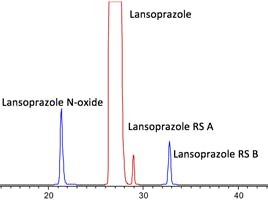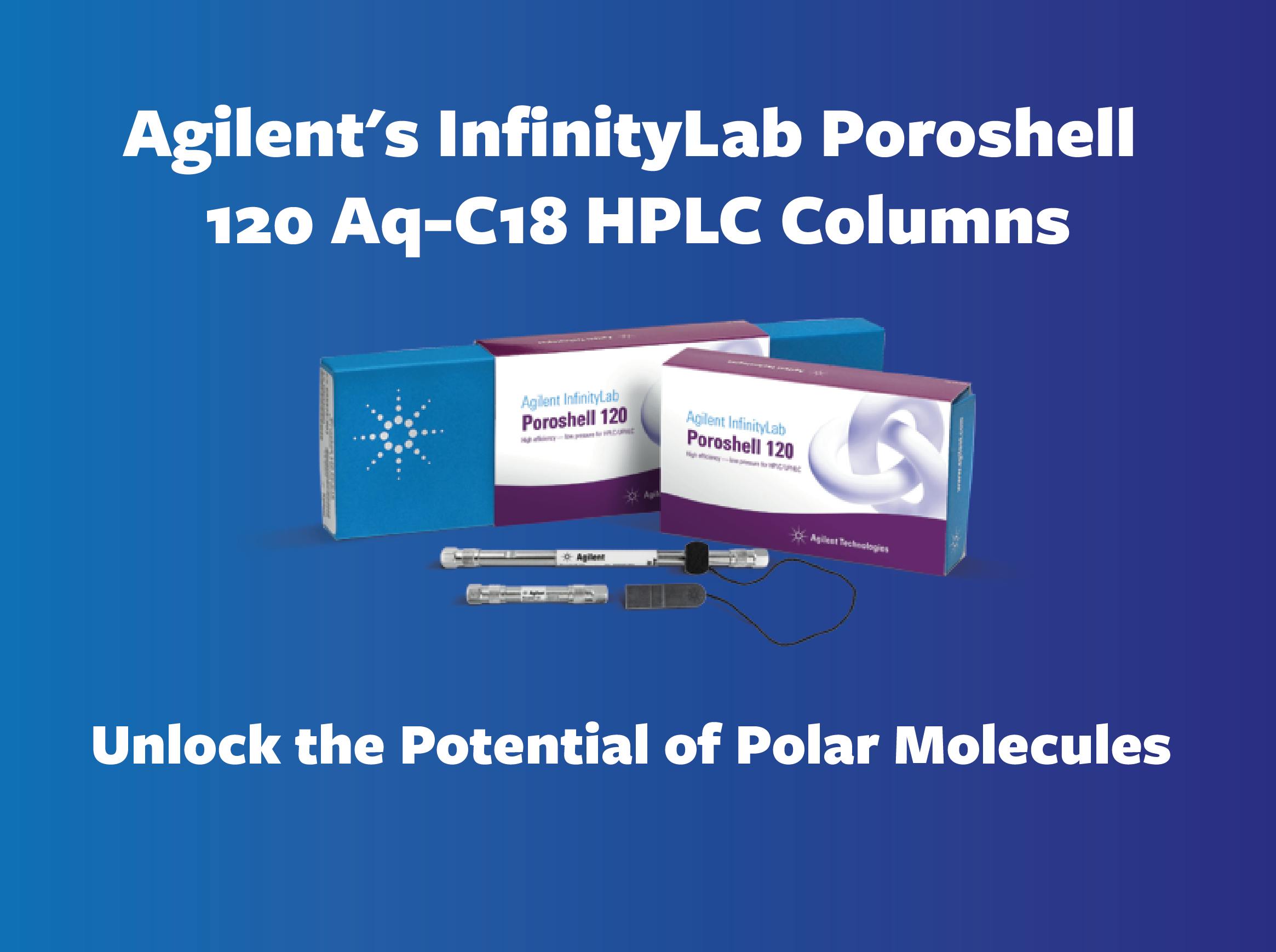
20 Mar 2024
Exploring the Unique Characteristics of Agilent InfinityLab Poroshell 120 C18 LC Columns
Exploring the Unique Characteristics of Agilent InfinityLab Poroshell 120 C18 LC Columns: EC-C18, SB-C18, HPH-C18, AQ-C18, and CS-C18
The InfinityLab Poroshell 120 column range from Agilent has expanded to offer thirteen bonded phases for use with reversed phase LC separations. Five of these phases fall under the C18 category with USP L1 classification; nevertheless, each one offers distinctive separation capabilities. In this article, we will demonstrate that not all C18s are the same and delve into the differences between the five C18 columns in the Poroshell portfolio: EC-C18, SB-C18, HPH-C18, AQ-C18, and CS-C18.
InfinityLab Poroshell 120 EC-C18 – Best all-round column for separation of a wide variety of analytes
InfinityLab Poroshell 120 EC-C18 columns are excellent general-purpose columns suitable for methods with a pH range of 2 -8. This column is often recommended as the first choice for method development due to its suitability for separating a wide range of compounds, including acids, neutrals, and bases.
Based on superficially porous silica, the EC-C18 column is manufactured with a dimethyl-n-octadecyl silane stationary phase. Endcapping with proprietary reagents ensures maximum deactivation of the surface to reduce unwanted secondary interactions with basic compounds. Three different particle sizes are available: 2.7 µm for UHPLC performance at lower pressures, 1.9 µm for highest UHPLC performance, or 4 µm for improved HPLC performance.

Figure 1: Phase graphic of the InfinityLab Poroshell 120 EC-C18 column [1]
The selectivity of the EC-C18 phase closely matches the fully porous ZORBAX Eclipse Plus C18 column. Changing to Poroshell 120 offers separation and throughput benefits associated with superficially porous columns, making it straightforward to update methods. In Figure 2, a legacy method is optimised on a Poroshell EC-C18 column and comparable resolution is achieved in significantly less time, enhancing analytical throughput by a factor of four.

Figure 2: Method transitioned from ZORBAX Eclipse Plus C18 to Poroshell 120 EC-C18 resulting in increase in throughput with comparable resolution [2]
InfinityLab Poroshell 120 SB-C18 – Best for use with low-pH mobile phases
InfinityLab Poroshell 120 SB-C18 columns offer the highest stability for low pH applications (down to pH 1), and can be used at elevated temperatures up to 90°C. The SB-C18 columns are a non-endcapped C18 phase manufactured with sterically protected diisobutyl side chain groups. The bulky silanes protect the siloxane bond from hydrolytic attack at low pH resulting in improved column lifetimes. Poroshell SB-C18 is available with superficially porous particles in 1.9 µm 2.7 µm, and 4 µm sizes, for high-resolution separations.

Figure 3: Phase graphic of the InfinityLab Poroshell 120 SB-C18 column [1]
The SB-C18 column is intentionally left unendcapped, providing enhanced alternative selectivity compared to the endcapped EC-C18 column. It is a versatile phase, suitable for analysis of acidic, basic, or neutral samples and can be used with aggressive low pH mobile phases. Figure 4 illustrates excellent peak shape for catechins in green tea and demonstrates the value of optimising the acidic modifier to improve LC/MS detection sensitivity.

Figure 4: InfinityLab Poroshell 120 SB-C18 screened with different acidic modifiers [2]
InfinityLab Poroshell 120 HPH-C18 – longest lifetimes under high pH conditions
For methods using high pH the InfinityLab Poroshell 120 HPC-C18 is the recommended choice. As retention and selectivity of ionisable compounds can change significantly under different pH conditions, having a high-pH compatible column in your screening toolkit can be beneficial. The selectivity of the HPH-C18 column closely resembles that of EC-C18, allowing straightforward method transfer when elevated pHs are necessary. Suitable for methods running up to pH 11, degradation of the silica surface at alkaline conditions is prevented by the unique, organically modified hybrid silica particle.

Figure 5: Phase graphic of the InfinityLab Poroshell 120 HPH-C18 column [1]
The use of Poroshell hybrid particle technology provides robust performance, resulting in increased lifetimes and reduced frequency of column changes. Figure 6 illustrates the stability of the HPH-C18 phase with consistent performance observed for over 2000 injections using a pH 10 buffer mobile phase.

Figure 6: No change in performance after 2000 injections at pH 10 using InfinityLab Poroshell 120 HPH-C18 [2]
InfinityLab Poroshell 120 Aq-C18 – 100% aqueous mobile phase compatibility
Chromatographers can maximise the retention of challenging polar analytes in reversed phase conditions by using InfinityLab Poroshell 120 Aq-C18 columns. These columns feature a proprietary endcapped surface and precisely controlled ligand bonding on Poroshell 2.7 µm superficially porous particles. This C18 phase is designed to be stable under 100% aqueous conditions without experiencing particle dewetting or phase collapse.

Figure 7: Phase graphic of the InfinityLab Poroshell 120 Aq-C18 column [1]
The Aq-C18 phase is ideal for method development of polar and non-polar compounds together. By starting methods at 100% aqueous conditions enhanced retention of polar compounds is achieved, while also separating non-polar analytes. Figure 8 demonstrates excellent retention and separation of water-soluble vitamins starting with a 100% phosphate buffer mobile phase.

Figure 8: Water soluble vitamins separated using Aq-C18 with 100% aqueous starting conditions [3]
InfinityLab Poroshell 120 CS-C18 - Improve performance for basic analytes with low ionic strength mobile phases
Superior peak shape can be achieved for basic compounds with the InfinityLab Poroshell 120 CS-C18 columns when using low ionic strength mobile phases such as formic acid. These columns are manufactured with Poroshell 2.7 µm superficially porous particles with a hybrid endcapped C18 stationary phase that has a charged surface. Based on HPH technology, these columns can be used under a wide pH range of 1 – 11.

Figure 9: Phase graphic of the InfinityLab Poroshell 120 CS-C18 column [1]
The CS-C18 phase offers distinctive selectivity compared to conventional C18 columns, enhancing the separation of critical components. It also exhibits enhanced performance when handling high sample loads, particularly for basic analytes. In Figure 10, improved peak shape is evident when using CS-C18 with a formic acid mobile phase for basic analytes, outperforming traditional C18 columns without sacrificing sensitivity.

Figure 10: InfinityLab Poroshell 120 CS-C18 comparison with traditional C18 columns [4]
In conclusion, the InfinityLab Poroshell EC-C18, SB-C18, HPH-C18, AQ-C18, and CS-C18 columns each bring unique characteristics to your method development toolkit. Whether it's all-round performance, stability at low or high pH, 100% aqueous compatibility, or improved results with low ionic strength mobile phases Agilent's Poroshell C18 columns cater to a diverse range of chromatographic needs. Researchers and analysts can choose the most suitable column based on the specific requirements of their applications, ensuring optimal results and success in their chromatographic methods.
References
[1] https://www.agilent.com/cs/library/posters/public/5991-9013EN_InfinityLab_Poroshell120_poster.pdf
[2] https://www.agilent.com/cs/library/brochures/5991-8750EN_InfinityLab_Poroshell120_brochure.pdf
[4] https://www.agilent.com/cs/library/flyers/public/flyer-CS-C18-5994-2720en-agilent.pdf










